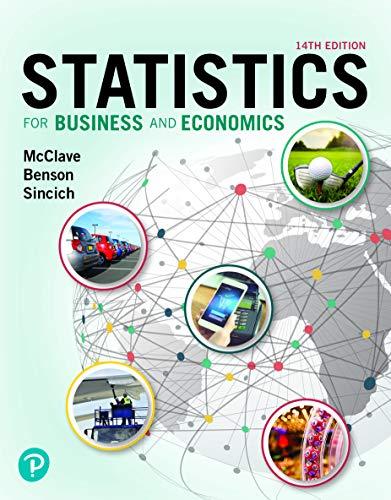For physicians confronted with ethical dilemmas (e.g., end-of-life issues or treatment of patients without insurance), many hospitals
Question:
For physicians confronted with ethical dilemmas (e.g., end-of-life issues or treatment of patients without insurance), many hospitals provide ethics consultation services. However, not all physicians take advantage of these services and some refuse to use ethics consultation. The extent to which doctors refuse ethics consults was studied in the Journal of Medical Ethics. Survey questionnaires were administered to all physicians on staff at a large community hospital in Tampa, Florida, and 118 physicians responded. Several qualitative variables were measured, including previous use of ethics consultation (“never used” or “used at least once”), practitioner specialty (“medical” or “surgical”), and future use of ethics consultation (“yes” or “no”).
a. Access the file and generate a graph that describes the level to which the physicians on staff have previously used the ethics consultation services. What proportion of the sampled physicians have never used ethics consultation?
b. Repeat part a for future use of ethics consultation. What proportion of the sampled physicians state that they will not use the services in the future?
c. Generate side-by-side graphs that illustrate differences in previous use of ethics consultation by medical and surgical specialists. What inference can you make from the graphs?
d. Repeat part C for future use of ethics consultation.
e. One of the quantitative variables measured in the survey of physicians was length of time in practice (i.e., years of experience). The medical researchers hypothesized that older, more experienced physicians would be less likely to use ethics consultation in the future. Generate two graphs to describe the distribution of years of experience—one for physicians who indicated they would use ethics consultation in the future and one for physicians who refused to use ethics consultation. Place the graphs side by side. Is there support for the researchers’ assertion? Explain.
f. Find the mean, median, and mode for the length of time in practice (i.e., years of experience) variable. Give a practical interpretation of each of these measures of central tendency.
g. Consider only the physicians who would refuse to use ethics consultation in the future. Find the mean, median, and mode for the length of time in practice for these physicians. Practically interpret the results.
h. Repeat part g for physicians who would use ethics consultation in the future.
i. Use the results, parts g and h, to comment on the medical researchers’ theory.
j. Find the range, variance, and standard deviation for the length of time in practice (i.e., years of experience) variable. If possible, give a practical interpretation of each of these measures of variation.
k. Consider only the physicians who would refuse to use ethics consultation in the future. Find the standard deviation for the length of time in practice for these physicians.
l. Repeat part k for physicians who would use ethics consultation in the future.
m. Use the results, parts k and l, to compare the variation in the length of time in practice distributions for physicians who would use and who would refuse ethics consultation in the future.
n. In addition to length of time in practice (i.e., years of experience), the researchers also measured the amount of exposure to ethics in medical school (number of hours) for the sample of 118 physicians. Create a scatterplot for these two variables. Plot years of experience on the vertical axis and amount of exposure to ethics in medical school on the horizontal axis. Comment on the strength of the association between these two variables.
o. Conduct an outlier analysis of the data for the variable amount of exposure to ethics in medical school. Identify the highly suspect outlier in the data set.
p. Remove the outlier, part o, from the data set and re-create the scatterplot of part n. What do you observe?
Step by Step Answer:

Statistics For Business And Economics
ISBN: 9780136855354
14th Edition
Authors: James T. McClave, P. George Benson, Terry T Sincich





